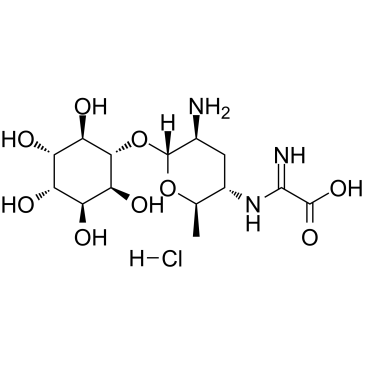Kasugamycin Hydrochloride

Kasugamycin Hydrochloride structure
|
Common Name | Kasugamycin Hydrochloride | ||
|---|---|---|---|---|
| CAS Number | 19408-46-9 | Molecular Weight | 415.824 | |
| Density | 1.97g/cm3 | Boiling Point | 628.2ºC at 760mmHg | |
| Molecular Formula | C14H26ClN3O9 | Melting Point | 203ºC (dec) | |
| MSDS | Chinese USA | Flash Point | 333.7ºC | |
|
Inactivation of KsgA, a 16S rRNA methyltransferase, causes vigorous emergence of mutants with high-level kasugamycin resistance.
Antimicrob. Agents Chemother. 53 , 193-201, (2009) The methyltransferases RsmG and KsgA methylate the nucleotides G535 (RsmG) and A1518 and A1519 (KsgA) in 16S rRNA, and inactivation of the proteins by introducing mutations results in acquisition of low-level resistance to streptomycin and kasugamycin, respec... |
|
|
Translation-independent localization of mRNA in E. coli.
Science 331(6020) , 1081-4, (2011) Understanding the organization of a bacterial cell requires the elucidation of the mechanisms by which proteins localize to particular subcellular sites. Thus far, such mechanisms have been suggested to rely on embedded features of the localized proteins. Her... |
|
|
Control of glutamate receptor 2 (GluR2) translational initiation by its alternative 3' untranslated regions.
Mol. Pharmacol. 76(6) , 1145-9, (2009) Four major glutamate receptor 2 (GluR2) transcripts differing in size (approximately 4 and approximately 6 kilobases) due to alternative 3' untranslated regions (UTRs), and also containing alternative 5'UTRs, exist in the brain. Both the long 5'UTR and long 3... |
|
|
Dissection of 16S rRNA methyltransferase (KsgA) function in Escherichia coli.
J. Bacteriol. 189(23) , 8510-8, (2007) A 16S rRNA methyltransferase, KsgA, identified originally in Escherichia coli is highly conserved in all living cells, from bacteria to humans. KsgA orthologs in eukaryotes possess functions in addition to their rRNA methyltransferase activity. E. coli Era is... |
|
|
The novel kasugamycin 2'-N-acetyltransferase gene aac(2')-IIa, carried by the IncP island, confers kasugamycin resistance to rice-pathogenic bacteria.
Appl. Environ. Microbiol. 78(16) , 5555-64, (2012) Kasugamycin (KSM), a unique aminoglycoside antibiotic, has been used in agriculture for many years to control not only rice blast caused by the fungus Magnaporthe grisea but also rice bacterial grain and seedling rot or rice bacterial brown stripe caused by B... |
|
|
DNA sequencing and transcriptional analysis of the kasugamycin biosynthetic gene cluster from Streptomyces kasugaensis M338-M1.
J. Antibiot. 59(1) , 18-28, (2006) Streptomyces kasugaensis M338-M1 produces the aminoglycoside antibiotic kasugamycin (KSM). We previously cloned, sequenced and characterized the KSM acetyltransferase, transporter, and some of the biosynthetic genes from this strain. To identify other potenti... |
|
|
Analysis of antibiotic fungicide kasugamycin in irrigation water by high performance liquid chromatography.
J. Environ. Sci. Health B 45(5) , 478-84, (2010) A high performance liquid chromatographic (HPLC) analysis method with an ultraviolet (UV) detector and an Aqua C18 (250 x 4.6 mm, Phenomenex) column were applied to analyze the antibiotic fungicide kasugamycin in water. An aromatic sulfonic acid spe column (B... |
|
|
Role of mitochondrial ribosome-dependent translation in germline formation in Drosophila embryos.
Mech. Dev. 122(10) , 1087-93, (2005) In Drosophila, mitochondrially encoded ribosomal RNAs (mtrRNAs) form mitochondrial-type ribosomes on the polar granules, distinctive organelles of the germ plasm. Since a reduction in the amount of mtrRNA results in the failure of embryos to produce germline ... |
|
|
kasT gene of Streptomyces kasugaensis M338-M1 encodes a DNA-binding protein which binds to intergenic region of kasU-kasJ in the kasugamycin biosynthesis gene cluster.
J. Antibiot. 55(12) , 1053-62, (2002) We previously reported that a 4.2 kb SacI-EcoRI DNA region from Streptomyces kasugaensis M338-M1, a kasugamycin (KSM) producer, included KSM transporter genes (kasKLM). As an extension of that study, a 3.7 kb Psti-SacI DNA region, located at 1.5 approximately... |
|
|
Exposure effect of fungicide kasugamycin on bacterial community in natural river sediment.
J. Environ. Sci. Health B 45(5) , 485-91, (2010) The degradation of kasugamycin in water and the effects of kasugamycin on the bacterial communities in sediment and overlying water were analyzed over a 30-day period. Kasugamycin is generally regarded as nontoxic to microorganisms, but in this study we demon... |